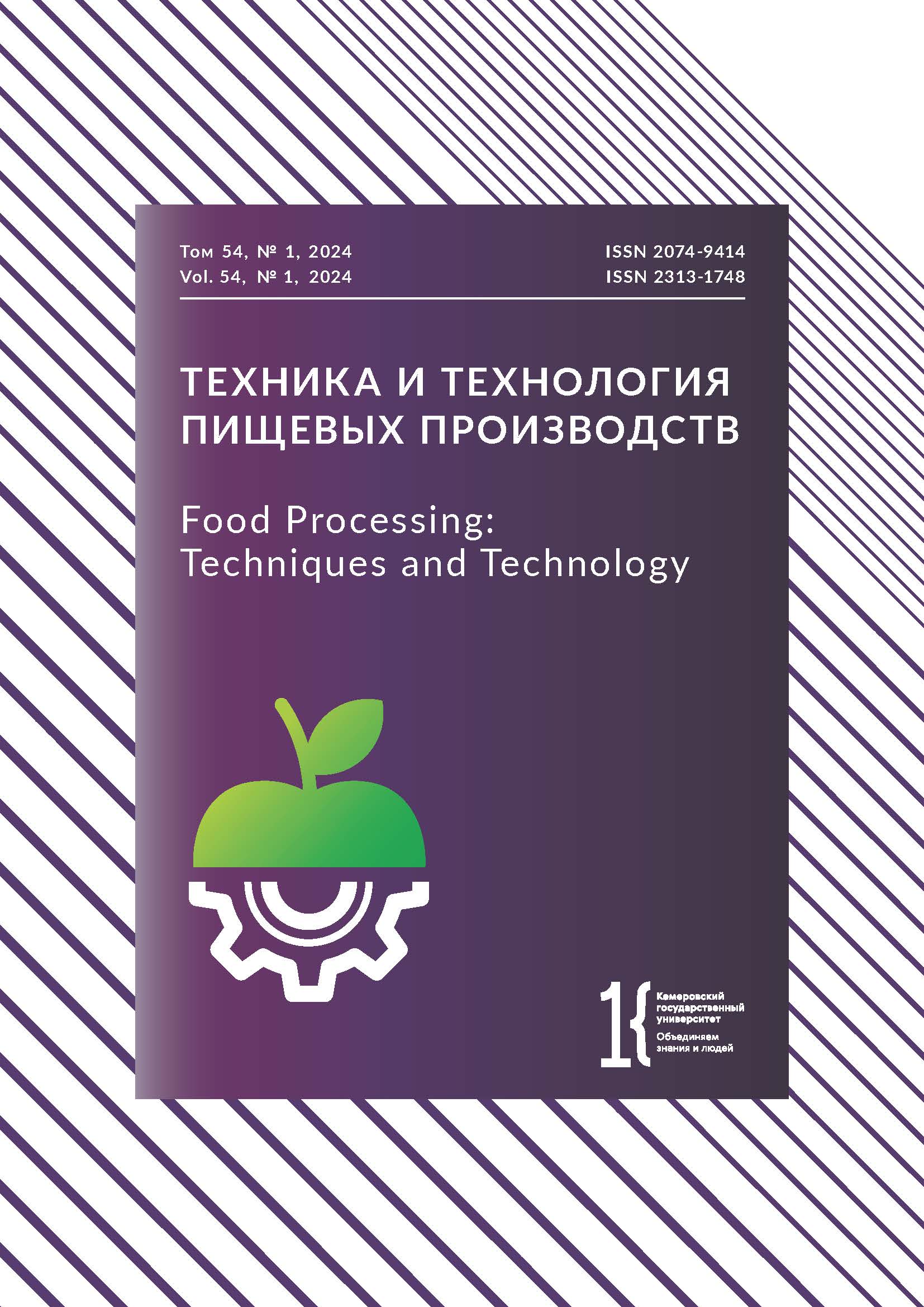Voronezh State University of Engineering Technologies
Voronezh, Voronezh, Russian Federation
Voronezh, Russian Federation
Military Educational and Scientific Centre of the Air Force N.E. Zhukovsky and Yu.A. Gagarin Air Force Academy of the Ministry of Defence of the Russian Federation
Voronezh, Voronezh, Russian Federation
Voronezh, Russian Federation
Voronezh, Voronezh, Russian Federation
Voronezh, Russian Federation
Voronezh, Voronezh, Russian Federation
VAK Russia 4.3.1
VAK Russia 4.3.3
UDC 66
Whipped yeast-free bakery products require effective energy supply to dough in order to optimize energy consumption, baking time, and quality. This article introduces a verified mathematical model of microwave and convective baking for whipped bread based on heat and mass exchange equations. A full-scale experiment to verify the calculations involved dough samples with a humidity of 56 ± 1%. The samples underwent microwave and convective processing until the temperature in the crumb center reached 98 ± 1°C. The mathematical model was formalized as energy and mass conservation equations, which made it possible to consider baking as a non-stationary process of heat and mass transfer of moisture in an isotropic incompressible continuous medium in the diffusion approximation. The equation took into account the unstable phase transition boundary. The practical verification showed the mean error for microwave baking as 14.5% in temperature and 18.2% in moisture content. For convective baking, the results included 12.6% in temperature and 9.7% in moisture content. The mathematical model proved adequate to the real processes of heat and mass transfer. The error in calculating the temperature and moisture content fields was sufficient tooptimize the process. The physical and mathematical model of the baking process made it possible to evaluate the effect of technological variables on the temperature and moisture concentration fields in the dough samples. The mathematical model and the computational experiment can be used to identify static and dynamic characteristics of baking as an object of automatic control, i.e., to identify optimal control channels and actions, as well as to adjust the automatic control system to specific quality indicators.
Bread, aerated dough, bread crumb, bread crusts, microwave baking, convection baking, heat and mass transfer, mathematical modeling, Stefan problem
1. Rudnev SD, Shevchenko TV, Ustinova YuV, Kryuk RV, Ivanov VV, Chistyakov AM. Technology and theory of mechanically activated water in bakery industry. Food Processing: Techniques and Technology. 2021;51(4):768–778. (In Russ.). https://doi.org/10.21603/2074-9414-2021-4-768-778
2. Kulishov BA, Novosyolov AG, Ivashchenko SYu, Gusarov NE. Electric contact heating in baking: A review. Polzunovsky Vestnik. 2019;(1):106–113. (In Russ.). https://doi.org/10.25712/ASTU.2072-8921.2019.01.020
3. Maklyukov VI. Analysis of methods for modeling the bread baking process. Bread Products. 2021;(7):26–32. (In Russ.). https://elibrary.ru/IQUUCR
4. Magomedov GO, Khvostov AA, Zhuravlev AA, Magomedov MG, Taratukhin AS, Plotnikova IV. Formation of whipped yeast-free bread crumb with intensive microwave convective baking. Food Processing: Techniques and Technology. 2022;52(3):426–438. (In Russ.). https://doi.org/10.21603/2074-9414-2022-3-2375
5. Purlis E, Cevoli C, Fabbri A. Modeling volume change and deformation in food products/processes: An overview. Foods. 2021;10(4). https://doi.org/10.3390/foods10040778
6. Houšová J, Hoke K. Temperature profiles in dough products during microwave heating with susceptors. Czech Journal of Food Sciences. 2002;20(4):151–160. https://doi.org/10.17221/3526-CJFS
7. Kristiawan M, Valle GD, Kansou K, Ndiaye A, Vergnes B. Validation and use for product optimization of a phenomenological model of starch foods expansion by extrusion. Journal of Food Engineering. 2018;246:160–178. https://doi.org/10.1016/j.jfoodeng.2018.11.006
8. Roohi R, Hashemi SMB. Experimental, heat transfer and microbial inactivation modeling of microwave pasteurization of carrot slices as an efficient and clean process. Food and Bioproducts Processing. 2020;121:113–122. https://doi.org/10.1016/j.fbp.2020.01.015
9. Pham ND, Khan MIH, Karim MA. A mathematical model for predicting the transport process and quality changes during intermittent microwave convective drying. Food Chemistry. 2020;325. https://doi.org/10.1016/j.foodchem.2020.126932
10. Purlis E. Modeling convective drying of foods: A multiphase porous media model considering heat of sorption. Journal of Food Engineering. 2019;263:132–146. https://doi.org/10.1016/j.jfoodeng.2019.05.028
11. Salah K, Olkhovatov EA, Aïder M. Effect of canola proteins on rice flour bread and mathematical modelling of the baking process. Journal of Food Science and Technology. 2019;56(8):3744–3753. https://doi.org/10.1007/s13197-019-03842-2
12. Garg A, Malafronte L, Windhab E. Baking kinetics of laminated dough using convective and microwave heating. Food and Bioproducts Processing. 2019;115:59–67. https://doi.org/10.1016/j.fbp.2019.02.007
13. Purlis E. Simple methods to predict the minimum baking time of bread. Food Control. 2019;104:217–223. https://doi.org/10.1016/j.foodcont.2019.04.021
14. Mosalam H. Digital modeling of heat transfer during the baking process. Modelling and Simulation in Engineering. 2021;2021. https://doi.org/10.1155/2021/8957148
15. Hou L, Li R, Wang S, Datta AK. Numerical analysis of heat and mass transfers during intermitten microwave drying of Chinese jujube (Zizyphus jujuba Miller). Food and Bioproducts Processing. 2021;129:10–23. https://doi.org/10.1016/j.fbp.2021.06.005
16. Schiano Di Cola V, Cuomo S, Severino G. Remarks on the numerical approximation of Dirac delta functions. Results in Applied Mathematics. 2021;12. https://doi.org/10.1016/j.rinam.2021.100200
17. Dien Vu K, Bazhenova S. Modeling the influence of input factors on foam concrete properties. Magazine of Civil Engineering. 2021;(3). https://doi.org/10.34910/MCE.103.11
18. Purlis E. Simple methods to predict the minimum baking time of bread. Food Control. 2019;104:217–223. https://doi.org/10.1016/j.foodcont.2019.04.021
19. Thuengtung S, Ogawa Y. Comparative study of conventional steam cooking and microwave cooking on cooked pigmented rice texture and their phenolic antioxidant. Food Science and Nutrition. 2020;8(2):965–972. https://doi.org/10.1002/fsn3.1377
20. Al-Nasser M, Fayssal I, Moukalled F. Numerical simulation of bread baking in a convection oven. Applied Thermal Engineering. 2020;184. https://doi.org/10.1016/j.applthermaleng.2020.116252












